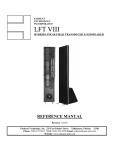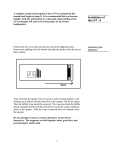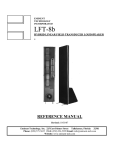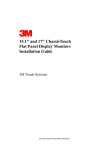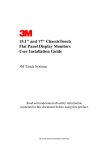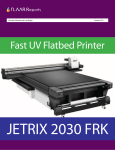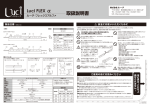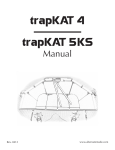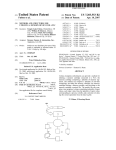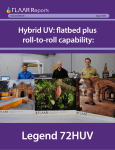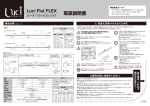Download Eminent LFT-10 Specifications
Transcript
EMINENT TECHNOLOGY INCORPORATED LFT XVI HYBRID LINEAR FIELD TRANSDUCER LOUDSPEAKER REFERENCE MANUAL Revised: 12/28/05 Eminent Technology, Inc. 225 East Palmer Street Tallahassee, Florida 32301 Phone: (850) 575-5655 FAX: (850) 224-5999 Email: [email protected] Website: www.eminent-tech.com Strong magnetic fields are present at and around this loudspeaker. Devices that are adversely affected by high levels of magnetic flux, such as television sets and pacemakers, should be kept at least three feet away from each speaker. Also, keep in mind when any ferrous objects are brought close to the speakers. Hold steel tools securely when setting up and adjusting the LFT-XVI, to prevent a hex key or screwdriver from slipping from your hand and damaging the Mylar diaphragm. ATTENTION: STRONG MAGNETIC FIELDS _____________ 2 TABLE OF CONTENTS Installation of the LFT-16........................................................... 5 Unpacking the Speakers............................................................. 5 Speaker Assembly...................................................................... 5 Positioning the Speakers in the Listening Room....................... 5 Imaging...................................................................................... 6 The Tweeter Level Control........................................................ 6 Amplifier Requirements............................................................. 6 Bi-Wiring and Bi-Amping......................................................... 7 Bi-Amping..................................................................................7 Technical Description.................................................................. 8 Electrostatic Loudspeakers.........................................................8 Planar Magnetic Loudspeakers.................................................. 9 Ribbon Loudspeakers............................................................... 10 Evaluating Earlier Approaches................................................ 11 Electrostatics............................................................................ 11 Planar Magnetics...................................................................... 12 Ribbons.................................................................................... 12 The Linear Field Transducer.................................................... 12 Diaphragm Construction.......................................................... 13 The Magnet/Frame Structure................................................... 13 Panel Frequencies.....................................................................15 General Specifications............................................................... 15 LFT-16 Impedance Curves........................................................16 LFT-16 Impedance Data............................................................17 Crossover Information...............................................................17 Frequency Response...................................................................18 LFT-16 Mid-Range Panel Specifications................................ 19 Mid-Range Panel Design........................................................... 20 LFT-16 Woofer Specifications.................................................. 20 Additional Woofer Specifications............................................. 22 Woofer Design............................................................................ 22 Woofer Enclosure....................................................................... 23 3 Warranty..................................................................................... 24 4 Installation of the LFT-16 A complete technical description of the LFT-16 is included in this manual and begins on page 7. It is recommended that you become familiar with this information because an understanding of the LFT principals will assist you in the proper set up of these loudspeakers. The LFT-16 is shipped in one box. The box contains the two hybrid linear field transducer loudspeakers. Remove the padding from the top and remove the grill cloth frames, which are wrapped in cardboard. Then remove one speaker separately from the box. Be careful not to put too much pressure on the woofer cone when lifting the speaker out of the box. After removing the speaker from its box place on the carpet or a soft surface. Unpacking the Speakers Do not attempt to remove or loosen hardware on the drivers themselves. The magnets are held together under great force and personal injury could result. Speaker Assembly There are two-assembly requirement for both speakers. To attach the grill cloth frames, place the additional Velcro fasteners to the corners of each speaker. Then snap the grill cloth into place. Second, adjust the setscrews at the bottom of the speaker. Use a 3/32 allen hex wrench to adjust the desired height. Do not attempt to remove setscrews for the bottom of each speaker. Speaker placement is critical for correct imaging, frequency balance, low frequency performance, and efficiency. The LFT-16 speakers are a mirror imaged pair and should be set up with the tweeter panels to the inside. Ideally the base of the speaker should be above the floor 2 feet or more. The use of a speaker stand is recommended. Wall mounting is suitable for home theater use. Low frequency performance in particular can be determined by the shape of the room and the speaker's distance from the wall immediately behind them. Typically, the optimal distance between the LFT’s and the rear wall is 1 to 5 feet in an average room. The overall frequency balance of the LFT-16 is somewhat affected by the degree to which the speakers are toed in toward the central listening position. The onaxis frequency response of the LFT-16 is essentially flat, and it is often best to 5 Positioning the Speakers in the Listening Room position the speakers so that the main listening position is about on axis with each speaker. Slight mid-range frequency balance changes can be obtained by pointing the speakers slightly away from the listening position. Adjusting the speakers’ degree of vertical tilt with the pointed feet can also alter this balance. Imaging Overall imaging depends primarily on the distance separating the two speakers relative to their distance from the preferred listening position; it is also affected by the degree of toe-in. We cannot accurately predict what will work best in your listening room, and can suggest only that you begin with the drawing on the previous page as a starting point or general guideline. Keep in mind that the parameters that affect frequency balance also tend to affect imaging properties, and vice versa, so it is best to adjust speaker placement in small increments and to note carefully all of the changes effected by each shift in position before proceeding further. The Tweeter Level Control The high frequency performance of the LFT-16 is adjusted with the tweeter level control. There are three tweeter level positions: High, Mid and Low. These levels adjust the tweeter output in approximately 3 dB increments. It is best to start with the tweeter level setting in the middle position. Adjust the speakers for the best overall frequency balance and then decide if more or less high frequency energy is needed. Amplifier Requirements The LFT-16 is wired for 8-ohm operation and is appropriate for use with most moderately powered tube and solid-state amplifiers. The efficiency is 85dB with a 2.83-volt drive (1 “8” ohm watt). The efficiency rating is lower than average. However, the LFT16 radiates a planar wave front, and as such, on axis its apparent efficiency at the listening position is higher than the numerical rating implies. The LFT-16 has a minimum rating of 25 watts per side, tube or solid state. It can handle “music power” levels (short term burst) of 200 watts or more with out difficulty. The largest recommended amplifier size for the LFT-16 is 200 watts. The LFT-16 does not require a high current amplifier. A receiver may be used if it has sufficient power. Tube amplifiers should be used with the 8-ohm tap. 6 The LFT-XVI is configured to allow bi-wiring or bi-amping with a minimum of trouble. Bi-Wiring and BiAmping Bi-wiring simply means connecting a single stereo amplifier (or two mono amps) to a pair of speakers by using two pairs of speaker cables. Connect the hot and ground conductors of a pair of cables to the same output terminals on one channel of the amplifier; the other ends are connected to the separate woofer and mid/tweeter inputs of the LFT-16 (All speaker cables should be the same length). The effects of biwiring tend to be subtle; the slight improvement may be worth the relatively modest cost of an extra pair or speaker cables. Bi-wiring also permits experimenting with different types of cables for the two inputs; you may find that one type is best suited for bass performance, while another works best on the mid/treble side. Bi-amping requires and additional stereo amplifier or pair of mono Bi-Amping amps. You will also need some means of insuring that only the desired portion of the frequency range reaches each amplifier. The simplest way to accomplish this is with an external electronic crossover; however, this can also be done by hard-wiring low-pass and high-pass filters into the inputs of the bass/mid and treble amplifiers, respectively. For the low/ frequency amp, a 180Hz low-pass filter (6 dB/octave) is required; for the mid/treble amp, a 180Hz. high-pass filter (also 6 dB/octave) is required. If you wish to pursue this method, your dealer or the manufacturer of your amplifiers should be able to help you determine the specific parts necessary. Note that you will also need a level control on either one of the stereo amps or on the crossover, regardless of which approach you take to bi-amping. Contact Eminent Technology or refer to the schematic in the back of this manual to modify the crossover for proper speaker operation. 7 Technical Description The Eminent Technology Linear Field Transducer is a full-range, push-pull, dynamic planar loudspeaker. In a sense, it is the magnetic equivalent of a push-pull electrostatic loudspeaker, differing in that it requires no step-up transformer or bias voltage, and that the audio signal is applied directly to its diaphragm. The LFT-XVI To fully understand the strengths of the LFT design, one must first consider the design and operation of this speaker's three most notable antecedents: the push-pull electrostatic loudspeaker (ESL); the traditional, single-ended planar magnetic loudspeaker, and the ribbon loudspeaker. Electrostatic Loudspeakers The electrostatic starts with a very thin (half mil or less) diaphragm made of Mylar or a similar material, to which a light coating of mildly conductive substance such as graphite has been applied. This diaphragm is suspended on a rigid frame and 8 sandwiched between two stationary conductive grids (usually perforated metal plates) called stators. FRAME FRONT STATOR REAR STATOR [PERFORATED METAL PLATE] CONDUCTIVE DIAPHRAM TO BIAS VOLTAGE SUPPLY RESISTOR TO AMPLIFIER TRANSFORMER -+ PUSH-PULL ELECTROSTATIC [TOP VIEW CROSS-SECTION] Spacing exaggerated to show detail A DC charge of high voltage (in the thousands of volts) but very low current, known as the bias voltage, is applied to the conductive diaphragm and kept constant. A step-up transformer is introduced to increase the usable voltage of the amplifier's output (while simultaneously decreasing the current), and the two ends of the transformer's output coil are connected to the two stators. As the amplifier produces a continuously varying AC voltage, (the amplified music signal), the charge on the two stators will also continuously change in synchronization with the music; and since the two stators are connected to two different ends of the transformer's output, one stator will take on a predominantly negative charge at the same time and to the same extent that the other stator takes on a predominantly positive charge. The constant-charge diaphragm will thus undergo a continuously changing state of attraction to and repulsion from the two stators as their polarization changes, and it is this motion that excites the air to the front and rear of the speaker and produces sound. Planar Magnetic Loudspeakers The traditional planar magnetic also starts with a thin Mylar diaphragm, one side of which is coated with adhesive and fitted with an aluminum wire voice grid, (analogous to the 9 voice coil of a conventional cone driver). The diaphragm is held taut in a metal frame. On the front of this frame is a large sheet of perforated metal, to which rows of vertically aligned strip magnets have been fastened. FRAME DIAPHRAM S PERMANENT STRIP MAGNETS N VOICE GRID [ACTUALLY A CONTINUIOS LOOP] S N PERFORATED METAL SHEET S - TO AMPLIFIER + SINGLE-ENDED PLANAR MAGNETIC [T OP VIEW CROSS-SECT ION] Spacing exaggerated to show detail From there, the operation of a single-ended planar magnetic loudspeaker is remarkably similar to that of a conventional cone driver: The amplifier's output is sent directly through the voice grid and, because it is suspended within a stationary magnetic field, the grid moves back and forth within that field in synchronization with the AC voltage that is the amplified music signal. Since the voice grid is permanently fastened to a taut diaphragm, the diaphragm also moves in synchronization with the music signal, exciting the air and producing sound. Ribbon Loudspeakers The third and final antecedent to consider is the ribbon: a distinctly different sort of transducer, but one that is similar (in principle, at least) to the single-ended planar magnetic. The ribbon’s primary distinction is that its “diaphragm” and “voice element” are one and the same. 10 A ribbon driver is based on a long, narrow strip of conductive material; in practice, thus far, all true ribbons have used a strip of very thin corrugated aluminum for this purpose. The two ends of this strip are electrically connected to the amplifier’s output, and are physically anchored such that the strip is suspended within a stationary magnetic field--with said magnets positioned at the edges of the strip. N ALUMINUM RIBBON ELEMENT PERMANENT MAGNET _ TO AMPLIFIER [LEADS CONNECTED TO TOP AND BOTTOM OF RIBBON ELEMENT] + S PERMANENT MAGNET RIBBON DRIVER [TOP VIEW CROSS-SECTION] The operating principle is straightforward from there: the amplifier’s output passes directly through the aluminum strip-which, because it is suspended within a permanent magnetic field, moves back and forth in synchronization with the signal, producing sound. Not surprisingly, each of the approaches described above has its own unique set of pros and cons. The electrostatic, because its diaphragm is so thin and light, offers exceptionally good transient response and reproduction of Electrostatics subtle, low-level musical detail. And, because it is a true push-pull device (i.e., its diaphragm is, by design, driven from both the front and the rear), the ESL operates in a linear fashion. Typically, gross distortion results only when the driving amplifier clips into the speaker, or when, in an attempt to play the speaker louder than its design allows, its step-up transformer reaches a point of saturation. Evaluating Earlier Approaches On the negative side of the ledger, the ESL does require passing the amplified musical signal through a transformer, which can introduce its 11 own colorations and non-linearities. Also, some ESLs are prone to a condition known as arcing: Under the conditions of stress induced by playing an ESL loudly, it is not uncommon for an electrical spark to jump between one stator and the diaphragm (a phenomenon exactly analogous to lightning), burning a minute hole in the diaphragm and, over time, ruining it. Planar Magnetics As for the planar magnetic, its strengths are similar to those of the ESL-although the addition of several feet of wire and an adhesive coat make for a somewhat more massive diaphragm, limiting this design’s transient capabilities by comparison. But the planar magnetic requires no step-up transformer or bias voltage supply, and it has the added benefit of being an extremely manageable load for most amplifiers. However, the most specific drawback of the traditional planar magnetic is that it is a singleended (as opposed to push-pull) device: As the diaphragm’s physical excursion increases, the voice grid moves further away from its optimal location within the permanent magnetic field (at least in one direction). Thus, at the very instant when this speaker is called upon to reproduce large-amplitude waveforms, it is least able to do so without distortion. Ribbons In many ways, a ribbon driver can be an excellent performer: the moving element (the “ribbon” itself) is extremely light, allowing good “speed” and transient performance as well as freedom from coloration. And there is no significant physical structure on either side of the ribbon’s radiating pattern. The ribbon’s main problem is not one of performance but of application: it cannot be used to reproduce low frequencies. To create a moving element large enough to generate frequencies lower than a few hundred Hz would mean moving opposing magnetic poles so far apart that they would no longer exert a sufficient magnetic field over the entire area of the ribbon. Also, when a ribbon is operated at frequencies approaching the element’s own resonant frequency (which is naturally quite low, due to its high compliance), the ribbon element stretches and “bows” to a point where it is no longer within the magnetic gap. To get around either of these problems means to move the permanent magnet structure from the edges of the element to one entire side of the element, and/or to bond the element to a “host” diaphragm, such as a sheet of Mylar, and to clamp that diaphragm around its perimeter. In either case the driver is no longer a ribbon; it is, in fact, a planar magnetic. To date, no one has succeeded in creating a full range ribbon loudspeaker. The Linear Field Transducer Eminent Technology’s Linear Field Transducer, introduced as the LFT, represents a new approach to the design and 12 construction of a high-quality loudspeaker*. It builds on the strengths of the above designs while eliminating many of their drawbacks. The construction of the LFT-16 begins by laminating a very thin sheet of aluminum foil to a half-mil-thick sheet of Mylar. A voice grid pattern, created by means of CAD (Computer-Aided Design) technology, is silk-screened onto the foil side; the remainder of the aluminum--the part not covered by ink from the silk-screening is chemically etched away, in a manner similar to the etching of traces on a printed-circuit board. The ink is then washed away, leaving a voice grid of near-perfect uniformity. This technique results in a diaphragm/voice coil grid that is still less than one mil in total thickness, and also permits relatively narrow spaces between the individual traces, so the diaphragm can be evenly driven over its entire surface. The Magnet/Frame Structure The magnet/frame structure developed for the LFT-16 is also unique. Eminent Technology builds its strip magnets into individual steel channels, the size and shape of which have been carefully designed to help “focus” the magnetic flux lines and concentrate the strength of the magnetic field on the appropriate area of the diaphragm/voice grid. These channels are then welded to steel crossbars, which in turn are bolted to the frame that holds the diaphragm in place. Interestingly, one of the biggest challenges faced in creating a true push-pull dynamic speaker was not a design consideration but rather a matter of construction difficulty: to assemble a perfectly rigid structure with very powerful permanent magnets at the front and the rear, both sides opposing each other with tremendous force. It was not until Eminent Technology developed a special method for this assembly procedure that the Linear Field Transducer became a reality. * The design and construction of the LFT is patented. 13 Diaphragm Construction By applying such new techniques to planar loudspeaker construction, Eminent Technology has been able to eliminate many of the flaws inherent in earlier designs. Cloth is used on the backside of the speaker to resistively load the diaphragm. This lowers the Q of the diaphragms free air resonance. The use of a welded channel-and-crossbar frame dispenses with the need for perforated sheet metal (an “off-the-shelf” material presumably used for reasons of economy and ease of manufacture.) thus greatly improving dispersion, especially at high frequencies. Since it is now possible to have a powerful, precisely aligned magnet structure on both sides of the diaphragm, true push-pull operation has been achieved: Regardless of the degree of excursion the diaphragm undergoes, the voice element is always optimally positioned within the magnetic field. The result is extremely linear performance throughout the audible range, with a profound increase in dynamic range and an absolute minimum of distortion. 14 Panel Frequencies Each LFT-XVI has two individual driver panels and a cone type woofer. The placement of the individual drivers is shown in the following diagram. 7.5 KHz and above 250 to 7.5 KHz To 250 Hz General Specifications Power Requirements 25 Watts minimum Sensitivity 85 dB (pink noise, 20 - 20kH) at 1 watt/1 meter (2.83 V) Frequency Response 45 Hz - 20 kHz ±4 dB (typical room) Phase Accuracy ± 20˚ 100 Hz-31 kHz High Frequency Level Flat, - 3dB, -6dB at 20kHz smooth roll off Impedance 8 Ohm rating 15 LFT-16 Impedance Curves Maximum SPL 103 dB at 1 meter Dimensions 9.75” wide by 21.5” high by 9.75” thick Shipping Weight 23 lbs. Each Warranty 3 years parts, 1 year labor Available Finishes Oak, Walnut, Black Painted Oak The LFT-XVI impedance is shown below. The impedance generally averages much higher than 8 ohms. This means that the speaker does not require a high current amplifier. Because of the lower than average efficiency you will still need an amplifier with a fairly high power rating (25 watts per channel or more). If an amplifier clips into the speaker it will probably be due to a voltage limitation. 16 LFT-16 Impedance The impedance curves are shown for the woofer and mid-range/tweeter inputs Data connected. With the woofer section in parallel with the mid-range/tweeter section, the impedance curve becomes essentially flat with a minimum of about 5.5 ohms occurring around 100 Hz and a maximum of 30 ohms at 7.5 kHz. The 30 ohm peak is with the tweeter in its low output position. When the tweeter level is moved up, its maximum will drop to about 27 ohms. The speaker should be considered as an “easy” 8-ohm load having only very small reactive components. Crossover Information LFT-16 Crossover Schematic LFT-16 Crossover Physical Layout 17 Frequency Response The LFT-16 system 10Hz to 30Khz frequency response with the microphone at 1 meter is shown below. Low frequency irregularities are a result of the testing room. Near Field response of the tweeter including the crossover measured from 10Khz to 50Khz. This tweeter should please dogs and cats and is SACD ready. 18 LFT-16 MidRange Panel Specifications Magnet Type Ceramic 8 Mid-range Diaphragm area 35 sq in Foil Thickness 0.0007 in Mylar Thickness 0.0005 in Laminate Adhesive Thickness 0.00015 in Gap Between Conductors 0.03 in Peak-to-Peak Diaphragm 0.12 in Displacement Diaphragm weight 1 Gram Free Air Resonance 120 Hz 19 Mid-Range Panel Design Do not attempt to disassemble these panels. The steel frame is preventing the panel from collapsing on itself. Removal of the cap screws that hold the panel together will surely cause damage to the diaphragm and may pinch hands and fingers. The mid-range panel design (shape and size) was chosen for good dispersion and bandwidth. For a given speaker design, there is a direct trade off between maximum sound pressure level, bandwidth and efficiency. In the LFT-16, the mid-range panel is usable from 100 Hz to about 40 kHz. However, there are problems if you use the panel over its full frequency range. At the upper frequency limit, the panel will beam because the wavelength becomes much shorter than the panel is wide. This is also the reason the speaker sounds best within the vertical axis of the mid-range panel. At the lower limit, the panels free air resonance is 120 Hz. This resonance is damped almost 100% with cloth on the back magnet channel assembly. Around 120 Hz at high sound pressure levels, the excursion limit of the diaphragm will be exceeded and it will slap against the magnet channel. A crossover point of 180 Hz is chosen to achieve a good maximum sound pressure level and still have the mid-range panel play vocal fundamentals and mid bass which is desirable for a good blend with the woofer. Since the lower crossover frequency is 6 dB per octave, the panel still has substantial output below 100 Hz. LFT-16 Woofer Specifications Near field response of the woofer 10Hz to 2Khz including the crossover network. The near field measurement removes most of the low frequency room modes. 20 Box Volume 9.181 Liters 605 in3 .687 ft3 Speaker Diameter 6.5 inch Magnet weight 20 oz. Impedance 6 Ohms Re 6.35 Ohms Le 0.60 mH fs 24.5 Hz ±15% Mmd 21.8 grams Mms 22.7 Grams 21 Additional Woofer Specifications Vas 46.8 Liters QM 2.77 QE 0.31 QT 0.28 Bl 8.47 Tm Xmax 4.25 mm Pmax 75 Watts Coil Diameter 1.5 in Gap Height 0.25 in Efficiency 0.22% SD 133.1 cm2 VD 56.6 cm3 EBP 79.3 Rms 1.258 N*sec/m Cms 1.861 mm/N Woofer Design 22 The design goal for the woofer is good transient response, low Q, low cutoff frequency and minimal coloration near the crossover region. In a hybrid system of this type, it is desirable to have as low a crossover frequency as possible for the woofer. Because of these factors we chose to design our on woofer. An six and half-inch woofer was chosen because it offered the best balance between low frequency response, the size of the box and blend with the mid-range driver. The woofer cone is purposely very heavy for an six and half-inch driver (22.7 grams). Since it is Q that defines transient performance. This mass (combined with a very complaint surround and spider) gives a very low Q in a small sealed enclosure. A second reason the cone is heavy is to prevent it from responding to mid-range signals, which would cause a poor blend with the mid-range panel. The cone material is felted paper, which is coated with a thick emulsion. This helps to mechanically roll off the woofer to prevent mid-range coloration. Without a crossover, the woofer response begins to roll off above about 1500 Hz and has no usable output above 5 kHz. This allowed the crossover to be 6 dB per octave. Since the efficiency between the mid-range and high frequency driver is slightly lower than average and bandwidth and efficiency and efficiency of a woofer system are inversely proportional, we are able to extend the low frequency performance of the woofer system. The woofer is a true air suspension design. This means the compliance of the air in the enclosure has a much larger effect on low frequency performance than the compliance of the woofer components (spider and surround). Woofer Enclosure The design goal for the woofer enclosure is: (1) To be as resonance free as possible (rigid) to prevent low frequency and mid-range colorations. 23 (2) To provide sufficient internal volume to give the desired frequency response. (3) To visually appear smaller than it is when attached to the rest of the speaker. Research has shown that even if the resonance levels of an enclosure are 40 or more dB below the signal levels of the woofer, they will still be audible because their harmonic structure is almost always different than that of the signal coming from the woofer itself. In order for the woofer to successfully blend with a planar mid-range driver, it must be very neutral. Eminent Technology engineers have a great deal of experience performing mode shape analysis using instrumentation on many different structures. The experience gained from this research was put into the design of the woofer enclosure. The shape of the enclosure results in only two of the six sides having the same shape. This means that the fundamental resonance of one side of the enclosure will not excite a different fundamental resonance of another side. The enclosure is internally braced with a total of four internal braces. The largest brace crosses the center of the box. Four other braces break up modes on the back and front surfaces. The box is constructed of a high-density particleboard and is then laminated. Product Design Credits: Project Engineer - Harold Brown Tweeter Design - Chris Von Hellerman (Eastech) Midrange Panel Design - Jeff Raley, Bruce Thigpen Woofer Design - Jerry McNutt (Eminence) Voicing - Bruce Thigpen Warranty Eminent Technology Inc. warrants the LFT-XVI Loudspeaker to be free from defects in materials and workmanship for a period of 30 days from the date of purchase. Within that period, any failure of the LFT-XVI will be corrected without charge for parts, labor, or transportation from the factory. After this period, pending receipt of the warranty form (filled out and mailed to Eminent Technology, and 24 postmarked no later than one month after the date of purchase), the above warranty will be extended to three years for parts and one year for labor. This warranty is transferable to subsequent owners, pending notification from the original owner, in writing, within 10 days of the personal sale. The obligation of Eminent Technology under the terms of this warranty does not extend to: 1. Any LFT-XVI installed or operated without regard for the instructions contained in this manual. 2. Any LFT-XVI while under performance testing, or after being used in such a test, by any personnel or facility not authorized by Eminent Technology. 3. Any other component or part connected to or operated in conjunction with the LFT- XVI. 4. Any traumatic, accidental damage, or damage incurred in shipping, or defects which upon examination by Eminent Technology and in its sole opinion have been caused by abuse, neglect, improper or abnormal installation, or operation for extended periods in industrial applications. This warranty is not applicable if any part of the LFT-XVI has been removed or taken apart, repaired, altered, or modified by anyone without prior authorization in writing from Eminent Technology, nor if the serial numbers have been defaced or rendered illegible. If an Eminent Technology product is removed from the country in which the original consumer purchase was made, Eminent Technology dealers and distributors in other countries are not obligated by the terms of this warranty. Eminent Technology reserves the right to incorporate design refinements and changes to its products without notice or obligation. If practical, such design modifications will be made available to owners of existing units for a reasonable charge. Under the terms of this warranty, Eminent Technology expressly does not insure for loss of use of the LFT due to failure or periods of repair. Warranty repairs will be carried out by the factory. The LFTXVI must be returned prepaid in its original factory carton to: Eminent Technology, Inc 225 East Palmer Street Tallahassee, FL 32301 (850) 575-5655 EMINENT TECHNOLOGY, INC. LFT-XVI WARRANTY FORM Name_______________________________________________________ 25 Address_____________________________________________________ City________________________________________________________ State_______________________ Zip_________________________ Dealer Purchased From_________________________________________ Dealer Address_______________________________________________ City________________________________________________________ State_______________________ Zip_________________________ Date Purchased _______________ Serial Number R________________ L________________ Please complete this form and return to: Eminent Technology 225 East Palmer Street Tallahassee, FL 32301 U. S. A. 26


























